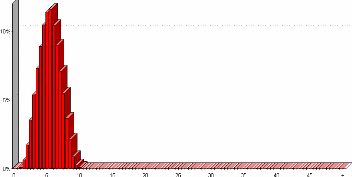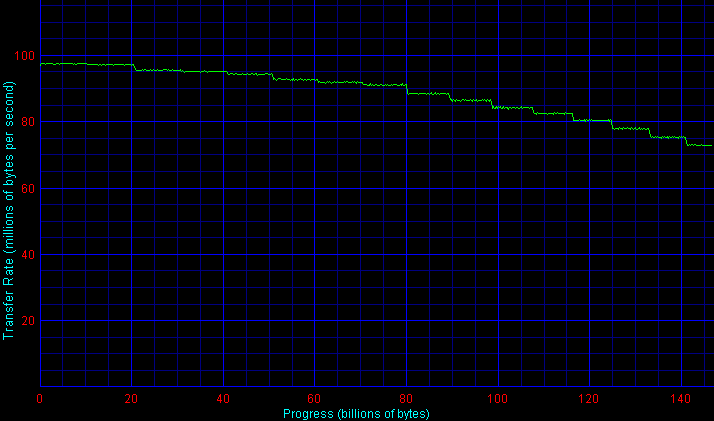Note: Since the publication of this review, this drive has been retested under Testbed4, a newer hardware/software/benchmark platform. Please see this article for updated results. This review remains for reference purposes only.
|
We enter an era where higher density does not necessarily translate into greater single-drive performance. It seems now more than ever that tightly-packed tracks, blistering speed, and solid reliability compete with one another for a manufacturer’s attention. Reliability, of course, can not be sacrificed to improve the other two factors. So, in the quest to climb to pack bits ever closer, it appears that the performance increases we have automatically associated with next-generation drives are hardly guaranteed.

With the 15K II, Maxtor at last makes the move to fluid-dynamic bearing (FDB) motors. Through reduced metal-metal contact and a better-isolated spindle shaft, FDB motor drives boast increased reliability while also reducing noise floors. An enterprise-standard 5-year warranty backs the drive.
Maxtor has initially shipped the Atlas 15K II equipped with a standard Ultra320 parallel SCSI configuration. Serial Attached SCSI (SAS)’s time is almost upon us
however- it is not unreasonable to expect an SAS version of the drive once controllers and other support infrastructures hit the market.
As a new-breed 15,000 RPM drive, the 15K II targets the most demanding storage applications around: heavy-load file and web servers, data mining/warehousing, busy transaction servers, and other uses where best-of-breed random access performance is mandatory. In the following tests, the Atlas is compared against the following drives for the subsequent reasons:
Maxtor Atlas 15K (73 GB) | Manufacturer’s previous-generation unit |
Fujitsu MAU3147 (147 GB) | Current-generation competing unit |
Fujitsu MAS3735 (73 GB) | Previous-generation competing unit |
Hitachi Ultrastar 15K73 (73 GB) | Previous-generation competing unit |
Seagate Cheetah 15K.4 (147 GB) | Current-generation competing unit |
Seagate Cheetah 15K.3 (73 GB) | Previous-generation competing unit |
Low-Level ResultsFor diagnostic purposes only, StorageReview measures the following low-level parameters: Average Read Access Time– An average of 25,000 random accesses of a single sector each conducted through IPEAK SPT’s AnalyzeDisk suite. The high sample size permits a much more accurate reading than most typical benchmarks deliver and provides an excellent figure with which one may contrast the claimed access time (claimed seek time + the drive spindle speed’s average rotational latency) provided by manufacturers. WB99 Disk/Read Transfer Rate – Begin– The sequential transfer rate attained by the outermost zones in the hard disk. The figure typically represents the highest sustained transfer rate a drive delivers. WB99 Disk/Read Transfer Rate – End– The sequential transfer rate attained by the innermost zones in the hard disk. The figure typically represents the lowest sustained transfer rate a drive delivers. |
For more information, please click here.
|
Note: Scores on top are better. |
|
|||||||||||||||||||||||
|
8E147L0 Average Read Service Time
|
||||||||||||||||||||||
|---|---|---|---|---|---|---|---|---|---|---|---|---|---|---|---|---|---|---|---|---|---|---|---|
With an average access time of just 5.5 milliseconds, the Atlas 15K II sets a new all-time record. Subtracting 2 ms to account for the latency of a 15K RPM spindle nets a measured average seek time of 3.5 milliseconds, a negligible 0.1 ms off of the firm’s 3.4 ms claim.
|
Note: Scores on top are better. |
|
|||||||||||||||||||||||||||||||||||||||||||||
|
|
||||||||||||||||||||||||||||||||||||||||||||
8E147L0 Transfer Rate
|
|||||||||||||||||||||||||||||||||||||||||||||
A very aggressive zoning pattern tops out with an outer-band transfer rate of 97.4 MB/sec, the closest a drive yet comes to breaking the symbolic 100 MB/sec barrier. Rates decay quite gracefully as heads move inwards and eventually bottom at an impressive 74.4 MB/sec- a score that would have been top-rate in an outer zone just one generation ago.
Single-User PerformanceStorageReview uses the following tests to assess non-server use: StorageReview.com Office DriveMark 2002– A capture of 30 minutes of actual computer productivity use that exactingly recreates a typical office-style multitasking environment. The applications include: Outlook XP, Word XP, Excel XP, PowerPoint XP, Calypso (a freeware e-mail client), SecureCRT v3.3 (a telnet/SSH client), CuteFTP Pro v1.0 (an FTP/SSH client), ICQ 2000b), Palm Hotsync 4.0, Gravity 2.3 (a Usenet/newsgroups client), PaintShop Pro v7.0, Media Player v8 for the occasional MP3, and Internet Explorer 6.0. StorageReview.com High-End DriveMark 2002– A capture of VeriTest’s Content Creation Winstone 2001 suite. Applications include Adobe Photoshop v5.5, Adobe Premiere v5.1, Macromedia Director v8.0, Macromedia Dreamweaver v3.0, Netscape Navigator v4.73, and Sonic Foundry Sound Forge v4.5. Unlike typical productivity applications, high-end audio- and video- editing programs are run in a more serial and less multitasked manner. The High-End DriveMark includes significantly more sequential transfers and write (as opposed to read) operations. |
StorageReview.com Bootup DriveMark 2002– A capture of the rather unusual Windows XP bootup process. Windows XP’s boot procedure involves significantly different access patterns and queue depths than those found in other disk accesses. This test recreates Windows XP’s bootup from the initial bootstrap load all the way to initialization and loading of the following memory-resident utilities: Dimension4 (a time synchronizer), Norton Antivirus 2002 AutoProtect, Palm Hotsync v4.0, and ICQ 2000b.
StorageReview.com Gaming DriveMark 2002– A weighted average of the disk accesses featured in five popular PC games: Lionhead’s Black & White v1.1, Valve’s Half-Life: Counterstrike v1.3, Blizzard’s Diablo 2: Lord of Destruction v1.09b, Maxis’s The Sims: House Party v1.0, and Epic’s Unreal Tournament v4.36. Games, of course, are not multitasked- all five titles were run in a serial fashion featuring approximately half an hour of play time per game.
For more information, please click here.
|
Note: Scores on top are better. |
The Atlas 15K II musters 725 I/Os per second in the SR Office DriveMark and squeaks by the recently-reviewed Fujitsu MAU3147 to capture the crown. Both drives improve significantly upon the scores delivered by their predecessors. Nothing else comes close.
In the SR High-End DriveMark, the Fujitsu tenaciously holds the top spot. The Atlas nonetheless delivers an impressive 637 I/Os per second and lags the MAU by just 1%.
Maxtor’s drive fails to touch the MAU, however, in the SR Bootup DriveMark. This capture of Windows XP’s actual bootup routine is an unusual pattern that features higher-than-normal average queue depths. The Atlas’s score of 641 I/Os per second, while impressive in its own right, falls behind the Fujitsu by a significant 19% margin.
The gap closes once again in the SR Gaming DriveMark. At 899 I/Os per second, the Atlas 15K II once more vies with the MAU for the top slot and comes up just slightly short.
Multi-User PerformanceStorageReview uses the following tests to assess server performance: StorageReview.com File Server DriveMark 2002– A mix of synthetically-created reads and writes through IOMeter that attempts to model the heavily random access that a dedicated file server experiences. Individual tests are run under loads with 1 I/O, 4 I/Os, 16 I/Os, and 64 I/Os outstanding. The Server DriveMark is a convenient at-a-glance figure derived from the weighted average of results obtained from the four different loads. StorageReview.com Web Server DriveMark 2002– A mix of synthetically-created reads through IOMeter that attempts to model the heavily random access that a dedicated web server experiences. Individual tests are run under loads with 1 I/O, 4 I/Os, 16 I/Os, and 64 I/Os outstanding. The Server DriveMark is a convenient at-a-glance figure derived from the weighted average of results obtained from the four different loads. For more information click here. |
|
Note: Scores on top are better. |
|
|||||||||||||||||||||||||||||||||||||||||||||
|
|
||||||||||||||||||||||||||||||||||||||||||||
Maxtor’s drive inches past Fujitsu’s older MAS3735 with an SR File Server DriveMark of 372 I/Os per second and is thus the first next-generation unit to finally deliver performance exceeding that of the scores turned in by drives now two years old.
Unfortunately, the Atlas 15K II does not fare quite as well in the SR Web Server DriveMark. Its score of 350 I/Os per second, while certainly respectable, lags slightly behind the MAS.
The usual caveats regarding capacity apply here- as always, highly random access benefits from higher densities through the reduction of sweeping actuator movements or the reduction of read/write head counts and the subsequent decrease in actuator mass. An Atlas 15K II with fewer arms on its actuator would likely fare better on a test that does not account for capacity effects such as IOMeter.
Legacy PerformanceeTesting Lab’s WinBench 99 Disk WinMark tests are benchmarks that attempt to measure desktop performance through a rather dated recording of high-level applications. Despite their age, the Disk WinMarks are somewhat of an industry standard. The following results serve only as a reference; SR does not factor them into final judgments and recommends that readers do the same. |
|
Note: Scores on top are better. |
|
|||||||||||||||||||||||||||||||||||||||||||||
|
|
||||||||||||||||||||||||||||||||||||||||||||
Heat and NoiseIdle Noise– The sound pressure emitted from a drive measured at a distance of 18 millimeters. The close-field measurement allows for increased resolution between drive sound pressures and eliminates interactions from outside environmental noise. Note that while the measurement is an A-weighted decibel score that weighs frequencies in proportion to human ear sensitivity, a low score does not necessarily predict whether or not a drive will exhibit a high-pitch whine that some may find intrusive. Conversely, a high score does not necessarily indicate that the drive exhibits an intrusive noise envelope. Net Drive Temperature– The highest temperature recorded from a 16-point sample of a drive’s top plate after it has been under heavy load for 80 minutes. The figures provided are net temperatures representing the difference between the measured drive temperature and ambient temperature. For more information, please click here. |
|
Note: Scores on top are better. |
|
|||||||||||||||||||||||||||||||||||||||||||||
|
|
||||||||||||||||||||||||||||||||||||||||||||
Like Fujitsu with its MAU3147, Maxtor has finally incorporated FDB motors into its top-end product. The result is a pleasantly-low idle sound. Though it has a long way to go to match the objective sound pressures delivered by today’s ATA drives, the Atlas 15K II’s idle noise nonetheless quickly fades into the background.
Seeks, of course, are a different story. The Atlas 15K II boasts the fastest access times yet seen here at SR. A powerful actuator is a loud actuator; one pays a price to have the swiftest random access performance possible.
At 30.6 degrees Celsius above ambient room temperature, the Atlas 15K II lands itself squarely in the middle of its brethren. Like any 15,000 RPM drive, the Atlas is intended for installation in cases featuring good airflow- a must to keep the unit within the range of acceptable operating temperatures.
ReliabilityThe StorageReview.com Reliability Survey aims to amalgamate individual reader experiences with various hard disks into a comprehensive warehouse of information from which meaningful results may be extracted. A multiple-layer filter sifts through collected data, silently omitting questionable results or results from questionable participants. A proprietary analysis engine then processes the qualified dataset. SR presents results to readers through a percentile ranking system. Note that the percentages in bold above may change as more information continues to be collected and analyzed. For more information, to input your experience with these and/or other drives, and to view comprehensive results, please visit the SR Drive Reliability Survey.
This of course begs a question: What did Maxtor do with the Atlas 15K II that Seagate and Fujitsu were either unable or unwilling to do? The answer remains purely in the realm of speculation. What we do know, however, is that the title of “World’s Fastest Hard Drive” has finally been wrested away from the Fujitsu MAS3735 and now lies with Maxtor’s Atlas 15K II.
Previous post: Seagate Cheetah 10K.7 Next post: Fujitsu MAT3300NP |




 Amazon
Amazon